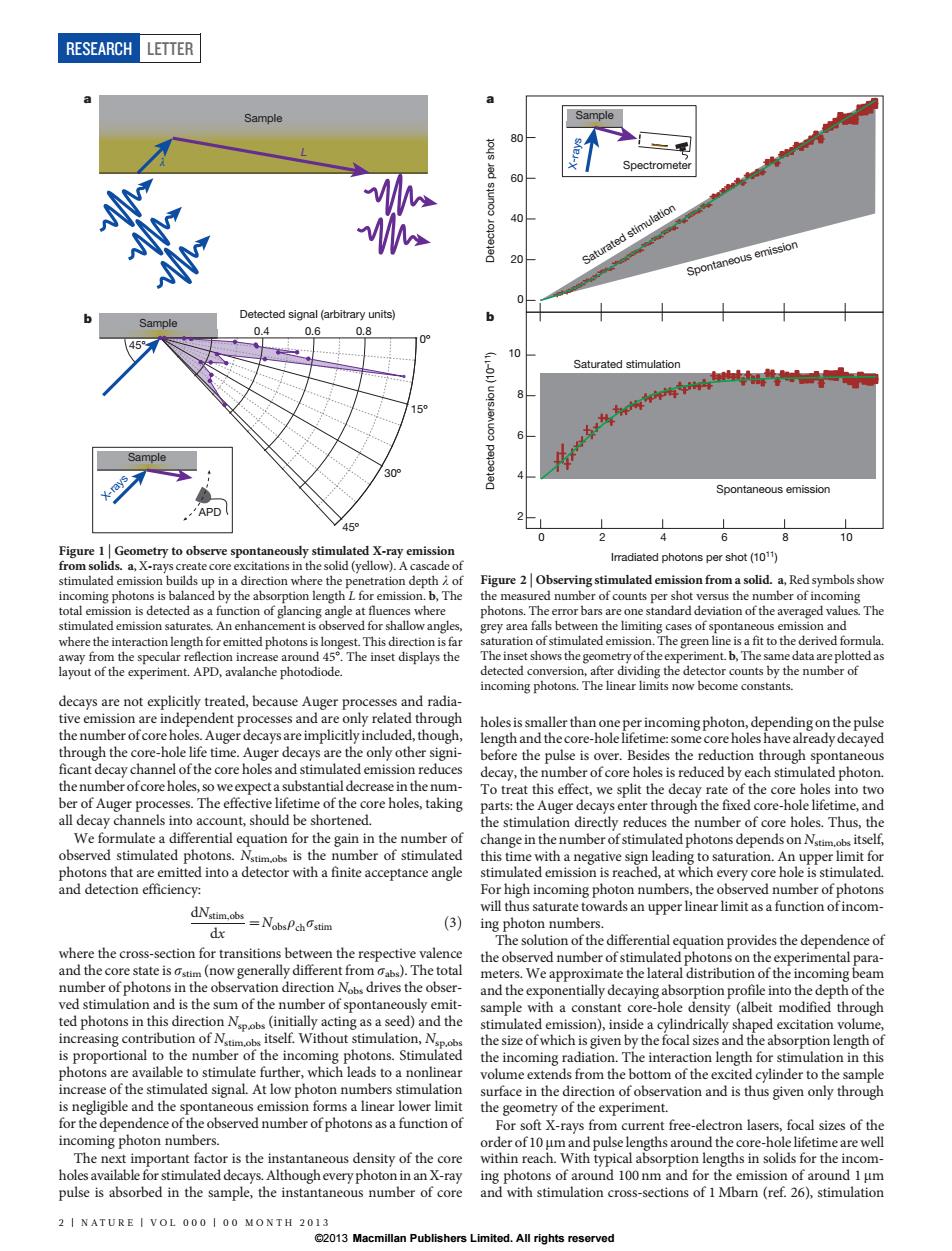正在加载图片...

RESEARCH LETTER Sample 80 Saturated stimulation 8 Spontaneous emission a x citatio ade o 20 by the ab ng ang dard de Th ne tion le ted photor This dinection is fu ed formul 5 the number of coreho r decays are implicitly included,though chan h 平 his detection ett h (3) ing photon numbers ides the dependence of the drives the obse and the ex bsorption pr (initially acting as eed)and the through hotons.stimulated ength o s from the is negligible and the of the xperiment photon numbers lengths in solidsfor thenm pulse is absorbed in the sample,the of cor decays are not explicitly treated, because Auger processes and radiative emission are independent processes and are only related through the number of core holes. Auger decays are implicitly included, though, through the core-hole life time. Auger decays are the only other significant decay channel of the core holes and stimulated emission reduces the number of core holes, so we expect a substantial decrease in the number of Auger processes. The effective lifetime of the core holes, taking all decay channels into account, should be shortened. We formulate a differential equation for the gain in the number of observed stimulated photons. Nstim,obs is the number of stimulated photons that are emitted into a detector with a finite acceptance angle and detection efficiency: dNstim,obs dx ~Nobsrchsstim ð3Þ where the cross-section for transitions between the respective valence and the core state is sstim (now generally different from sabs). The total number of photons in the observation direction Nobs drives the observed stimulation and is the sum of the number of spontaneously emitted photons in this direction Nsp,obs (initially acting as a seed) and the increasing contribution of Nstim,obs itself. Without stimulation, Nsp,obs is proportional to the number of the incoming photons. Stimulated photons are available to stimulate further, which leads to a nonlinear increase of the stimulated signal. At low photon numbers stimulation is negligible and the spontaneous emission forms a linear lower limit for the dependence of the observed number of photons as a function of incoming photon numbers. The next important factor is the instantaneous density of the core holes available for stimulated decays. Although every photon in an X-ray pulse is absorbed in the sample, the instantaneous number of core holes is smaller than one per incoming photon, depending on the pulse length and the core-hole lifetime: some core holes have already decayed before the pulse is over. Besides the reduction through spontaneous decay, the number of core holes is reduced by each stimulated photon. To treat this effect, we split the decay rate of the core holes into two parts: the Auger decays enter through the fixed core-hole lifetime, and the stimulation directly reduces the number of core holes. Thus, the change in the number of stimulated photons depends onNstim,obs itself, this time with a negative sign leading to saturation. An upper limit for stimulated emission is reached, at which every core hole is stimulated. For high incoming photon numbers, the observed number of photons will thus saturate towards an upper linear limit as a function of incoming photon numbers. The solution of the differential equation provides the dependence of the observed number of stimulated photons on the experimental parameters. We approximate the lateral distribution of the incoming beam and the exponentially decaying absorption profile into the depth of the sample with a constant core-hole density (albeit modified through stimulated emission), inside a cylindrically shaped excitation volume, the size of which is given by the focal sizes and the absorption length of the incoming radiation. The interaction length for stimulation in this volume extends from the bottom of the excited cylinder to the sample surface in the direction of observation and is thus given only through the geometry of the experiment. For soft X-rays from current free-electron lasers, focal sizes of the order of 10 mm and pulse lengths around the core-hole lifetime are well within reach. With typical absorption lengths in solids for the incoming photons of around 100 nm and for the emission of around 1 mm and with stimulation cross-sections of 1 Mbarn (ref. 26), stimulation a Detected signal (arbitrary units) Sample 0.4 0.6 0.8 0º 15º 30º 45º 45° b Sample λ L X-rays APD Sample Figure 1 | Geometry to observe spontaneously stimulated X-ray emission from solids. a, X-rays create core excitations in the solid (yellow). A cascade of stimulated emission builds up in a direction where the penetration depth l of incoming photons is balanced by the absorption length L for emission. b, The total emission is detected as a function of glancing angle at fluences where stimulated emission saturates. An enhancement is observed for shallow angles, where the interaction length for emitted photons is longest. This direction is far away from the specular reflection increase around 45u. The inset displays the layout of the experiment. APD, avalanche photodiode. 0 20 40 60 80 Detector counts per shot Spontaneous emission Saturated stimulation Irradiated photons per shot (1011) 0 2 4 6 8 10 2 4 6 8 10 Detected conversion (10–11) Spontaneous emission Saturated stimulation a b X-rays Sample Spectrometer Figure 2 | Observing stimulated emission from a solid. a, Red symbols show the measured number of counts per shot versus the number of incoming photons. The error bars are one standard deviation of the averaged values. The grey area falls between the limiting cases of spontaneous emission and saturation of stimulated emission. The green line is a fit to the derived formula. The inset shows the geometry of the experiment. b, The same data are plotted as detected conversion, after dividing the detector counts by the number of incoming photons. The linear limits now become constants. RESEARCH LETTER 2 | NATURE | VOL 000 | 00 MONTH 2013 ©2013 Macmillan Publishers Limited. All rights reserved